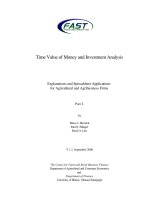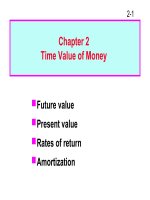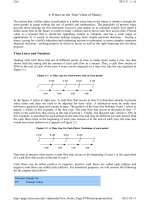Chapter 5 introduction to valuation the time value of money
Bạn đang xem bản rút gọn của tài liệu. Xem và tải ngay bản đầy đủ của tài liệu tại đây (220.22 KB, 35 trang )
Chapter 5
Calculators
Calculators
Introduction to
Valuation: The Time
Value of Money
McGraw-Hill/Irwin
Copyright © 2010 by The McGraw-Hill Companies, Inc. All rights reserved.
Key Concepts and Skills
•
Be able to compute the future value of an
investment made today
•
Be able to compute the present value of cash to be
received at some future date
•
Be able to compute the return on an investment
•
Be able to compute the number of periods that
equates a present value and a future value given
an interest rate
•
Be able to use a financial calculator and a
spreadsheet to solve time value of money
problems
5C-2
Chapter Outline
•
Future Value and Compounding
•
Present Value and Discounting
•
More about Present and Future
Values
5C-3
Basic Definitions
•
Present Value – earlier money on a time line
•
Future Value – later money on a time line
•
Interest rate – “exchange rate” between
earlier money and later money
–
Discount rate
–
Cost of capital
–
Opportunity cost of capital
–
Required return
5C-4
Future Values
•
Suppose you invest $1,000 for one year at 5%
per year. What is the future value in one year?
–
Interest = 1,000(.05) = 50
–
Value in one year = principal + interest =
1,000 + 50 = 1,050
–
Future Value (FV) = 1,000(1 + .05) = 1,050
•
Suppose you leave the money in for another
year. How much will you have two years from
now?
–
FV = 1,000(1.05)(1.05) = 1,000(1.05)
2
=
1,102.50
5C-5
Future Values: General
Formula
•
FV = PV(1 + r)
t
–
FV = future value
–
PV = present value
–
r = period interest rate, expressed as a
decimal
–
t = number of periods
•
Future value interest factor = (1 + r)
t
5C-6
Effects of Compounding
•
Simple interest
•
Compound interest
•
Consider the previous example
–
FV with simple interest = 1,000 + 50 +
50 = 1,100
–
FV with compound interest = 1,102.50
–
The extra 2.50 comes from the interest
of .05(50) = 2.50 earned on the first
interest payment
5C-7
Calculator Keys
•
Texas Instruments BA-II Plus
–
FV = future value
–
PV = present value
–
I/Y = period interest rate
•
P/Y must equal 1 for the I/Y to be the period rate
•
Interest is entered as a percent, not a decimal
–
N = number of periods
–
Remember to clear the registers (CLR TVM)
after each problem
–
Other calculators are similar in format
5C-8
Future Values – Example 2
•
Suppose you invest the $1,000 from the previous
example for 5 years. How much would you have?
–
5 N; 5 I/Y; 1,000 PV
–
CPT FV = -1,276.28
•
The effect of compounding is small for a small
number of periods, but increases as the number of
periods increases. (Simple interest would have a
future value of $1,250, for a difference of $26.28.)
5C-9
Future Values – Example 3
•
Suppose you had a relative deposit $10 at 5.5%
interest 200 years ago. How much would the
investment be worth today?
–
200 N; 5.5 I/Y; -10 PV
–
CPT FV = -447,189.84
•
What is the effect of compounding?
–
Simple interest = 10 + 200(10)(.055) = 120.00
–
Compounding added $447,069.84 to the value of
the investment
5C-10
Future Value as a General
Growth Formula
•
Suppose your company expects to
increase unit sales of widgets by 15% per
year for the next 5 years. If you sell 3
million widgets in the current year, how
many widgets do you expect to sell in the
fifth year?
–
5 N;15 I/Y; 3,000,000 PV
–
CPT FV = -6,034,072 units (remember the
sign convention)
5C-11
Quick Quiz – Part I
•
What is the difference between simple
interest and compound interest?
•
Suppose you have $500 to invest and you
believe that you can earn 8% per year
over the next 15 years.
–
How much would you have at the end of 15
years using compound interest?
–
How much would you have using simple
interest?
5C-12
Present Values
•
How much do I have to invest today to have
some amount in the future?
–
FV = PV(1 + r)
t
–
Rearrange to solve for PV = FV / (1 + r)
t
•
When we talk about discounting, we mean finding
the present value of some future amount.
•
When we talk about the “value” of something, we
are talking about the present value unless we
specifically indicate that we want the future value.
5C-13
Present Value – One Period
Example
•
Suppose you need $10,000 in one year for the
down payment on a new car. If you can earn 7%
annually, how much do you need to invest today?
•
PV = 10,000 / (1.07)
1
= 9,345.79
•
Calculator
–
1 N; 7 I/Y; 10,000 FV
–
CPT PV = -9,345.79
5C-14
Present Values – Example 2
•
You want to begin saving for your
daughter’s college education and you
estimate that she will need $150,000 in 17
years. If you feel confident that you can
earn 8% per year, how much do you need to
invest today?
–
N = 17; I/Y = 8; FV = 150,000
–
CPT PV = -40,540.34 (remember the sign
convention)
5C-15
Present Values – Example 3
•
Your parents set up a trust fund for you
10 years ago that is now worth
$19,671.51. If the fund earned 7% per
year, how much did your parents invest?
–
N = 10; I/Y = 7; FV = 19,671.51
–
CPT PV = -10,000
5C-16
Present Value – Important
Relationship I
•
For a given interest rate – the longer the
time period, the lower the present value
–
What is the present value of $500 to be
received in 5 years? 10 years? The discount
rate is 10%
–
5 years: N = 5; I/Y = 10; FV = 500
CPT PV = -310.46
–
10 years: N = 10; I/Y = 10; FV = 500
CPT PV = -192.77
5C-17
Present Value – Important
Relationship II
•
For a given time period – the higher the
interest rate, the smaller the present value
–
What is the present value of $500 received in
5 years if the interest rate is 10%? 15%?
•
Rate = 10%: N = 5; I/Y = 10; FV = 500
CPT PV = -310.46
•
Rate = 15%; N = 5; I/Y = 15; FV = 500
CPT PV = -248.59
5C-18
Quick Quiz – Part II
•
What is the relationship between present
value and future value?
•
Suppose you need $15,000 in 3 years. If
you can earn 6% annually, how much do
you need to invest today?
•
If you could invest the money at 8%,
would you have to invest more or less
than at 6%? How much?
5C-19
The Basic PV Equation -
Refresher
•
PV = FV / (1 + r)
t
•
There are four parts to this equation
–
PV, FV, r and t
–
If we know any three, we can solve for the
fourth
•
If you are using a financial calculator, be
sure to remember the sign convention or
you will receive an error (or a nonsense
answer) when solving for r or t
5C-20
Discount Rate
•
Often we will want to know what the
implied interest rate is on an investment
•
Rearrange the basic PV equation and
solve for r
–
FV = PV(1 + r)
t
–
r = (FV / PV)
1/t
– 1
•
If you are using formulas, you will want to
make use of both the y
x
and the 1/x keys
5C-21
Discount Rate – Example 1
•
You are looking at an investment that will
pay $1,200 in 5 years if you invest $1,000
today. What is the implied rate of
interest?
–
r = (1,200 / 1,000)
1/5
– 1 = .03714 = 3.714%
–
Calculator – the sign convention matters!!!
•
N = 5
•
PV = -1,000 (you pay 1,000 today)
•
FV = 1,200 (you receive 1,200 in 5 years)
•
CPT I/Y = 3.714%
5C-22
Discount Rate – Example 2
•
Suppose you are offered an investment
that will allow you to double your money in
6 years. You have $10,000 to invest.
What is the implied rate of interest?
–
N = 6
–
PV = -10,000
–
FV = 20,000
–
CPT I/Y = 12.25%
5C-23
Discount Rate – Example 3
•
Suppose you have a 1-year old son and you
want to provide $75,000 in 17 years towards
his college education. You currently have
$5,000 to invest. What interest rate must
you earn to have the $75,000 when you
need it?
–
N = 17; PV = -5,000; FV = 75,000
–
CPT I/Y = 17.27%
5C-24
Quick Quiz – Part III
•
What are some situations in which you
might want to know the implied interest
rate?
•
You are offered the following investments:
–
You can invest $500 today and receive $600 in
5 years. The investment is low risk.
–
You can invest the $500 in a bank account
paying 4%.
–
What is the implied interest rate for the first
choice, and which investment should you
choose?
5C-25









